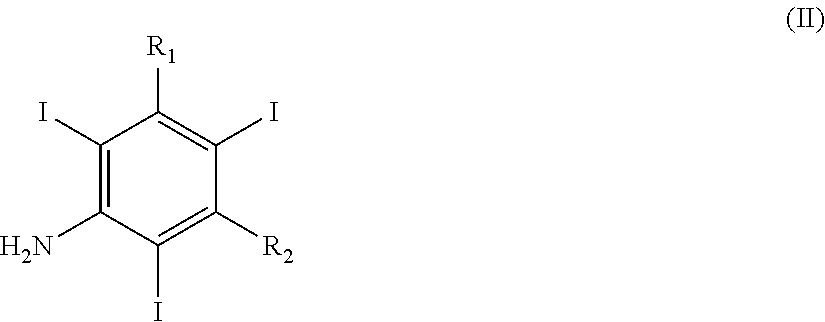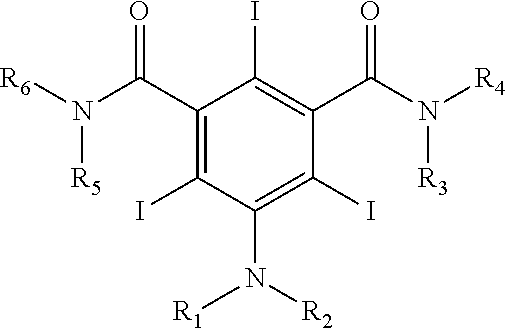Iodination Process for the Preparation of 3, 5-Disubstituted-2, 4, 6-Triiodo Aromatic Amines Compounds
- Summary
- Abstract
- Description
- Claims
- Application Information
AI Technical Summary
Benefits of technology
Problems solved by technology
Method used
Image
Examples
example 1
Preparation of 5-Amino-N,N′-bis-(2-hydroxy-1-hydroxymethyl-ethyl)-2,4,6-triiodo-isophthalamide
[0086]In a 1000-ml three-necked round-bottom flask is added water (100 mL), iodine (45.1 g, 0.178 mol), potassium iodate (15.6 g, 0.073 mol), anhydrous sodium sulfate (2.1 g, 0.015 mol) are added under mechanical stirring, followed by dropwise addition of 15% H2SO4 (50 g, 0.076 mol). After 2 h of stirring at 40° C., an aqueous solution of 5-amino-N,N′-bis-(2-hydroxy-1-hydroxymethyl-ethyl)-isophthalamide (380 mL, 0.124 mol) is added at 65° C. during 4 h. After 12 h of reaction at 80° C., additional potassium iodate (2.2 g, 0.010 mol) is added, maintain the temperature and continuing the reaction for 20 h. After reaction is complete, the temperature is increased to sublime residual iodine which is then collected in the iodine trap.
[0087]After cooling to 20° C., the solid is collected by using vacuum filtration and the filter cake suspended in water (250 mL), stirred at 80° C. for 1 h. Sodium ...
example 2
Preparation of 5-Amino-N,N′-bis-(2-hydroxy-1-hydroxymethyl-ethyl)-2,4,6-triiodo-isophthalamide
[0089]In a 1000-ml three-necked round-bottom flask is added water (120 mL), iodine (59.5 g, 0.234 mol), potassium iodate (25.1 g, 0.117 mol), anhydrous sodium sulfate (3 g, 0.021 mol) are added under mechanical stirring, followed by dropwise addition of 15% H2SO4 (66 g, 0.101 mol). After 2 h of stirring at 40° C., an aqueous solution of 5-amino-N,N′-bis-(2-hydroxy-1-hydroxymethyl-ethyl)-isophthalamide (473 mL, 0.168 mol) is added at 65° C. during 4 h. After 12 h of reaction at80° C., additional potassium iodate (3 g, 0.014 mol) is added, maintaining the temperature and continuing the reaction for 24 h. After the reaction is complete, the temperature is increased to sublime residual iodine which is then collectedin the iodine trap.
[0090]After cooling to 20° C., the solid is collected by filtration under vacuum and the filter cake is suspended in water (600 mL) and stirred at 80° C. for 2 h. ...
example 3
Preparation of 5-Amino-N,N′-bis-(2-hydroxy-1-hydroxymethyl-ethyl)-2,4,6-triiodo-isophthalamide
[0091]In a 1000-ml three-necked round-bottom flask is added water (150 mL), followed by dropwise addition of 15% H2SO4 (66 g, 0.101 mol). Iodine (54.6 g, 0.215 mol), potassium iodate (21.2 g, 0.099 mol), anhydrous sodium sulfate (2.9 g, 0.020 mol) are added under mechanical stirring. After 1.5 h of stirring at 45° C., an aqueous solution of 5-amino-N,N′-bis-(2-hydroxy-1-hydroxymethyl-ethyl)-isophthalamide (440 mL, 0.168 mol) is added at 65° C. during 4 h.
[0092]After 19 h of reaction, additional potassium iodate (2.9 g, 0.014 mol) is added, the iodine trap(containing more than 2.6 g of recycled iodine)is connected to the iodination reaction vessel and heated to 90° C. to introduce iodine gas into the reaction. The temperature is maintained at 80° Cand the reaction continued for 24 h. After reaction is complete, the temperature is increased to sublime residual iodine which is then collected i...
PUM
| Property | Measurement | Unit |
|---|---|---|
| Temperature | aaaaa | aaaaa |
| Temperature | aaaaa | aaaaa |
| Temperature | aaaaa | aaaaa |
Abstract
Description
Claims
Application Information
 Login to View More
Login to View More - R&D
- Intellectual Property
- Life Sciences
- Materials
- Tech Scout
- Unparalleled Data Quality
- Higher Quality Content
- 60% Fewer Hallucinations
Browse by: Latest US Patents, China's latest patents, Technical Efficacy Thesaurus, Application Domain, Technology Topic, Popular Technical Reports.
© 2025 PatSnap. All rights reserved.Legal|Privacy policy|Modern Slavery Act Transparency Statement|Sitemap|About US| Contact US: help@patsnap.com



